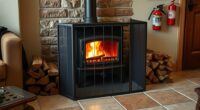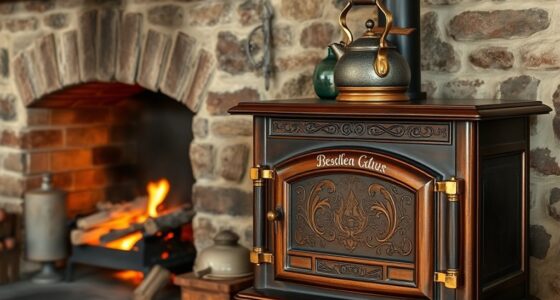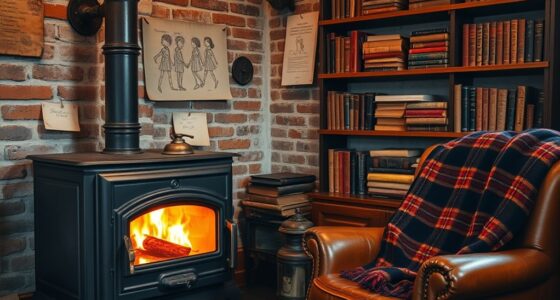From Franklin to today, the history of wood stoves shows how heating technology has evolved from primitive fires to advanced, eco-friendly designs. Early methods used basic fires, while Benjamin Franklin revolutionized stove efficiency and safety. The industrial era brought mass production, making stoves more accessible. Modern models focus on safety, emissions reduction, and smart features. To see how these innovations continue shaping homes, keep exploring this fascinating journey.
Key Takeaways
- Early wood fires evolved into primitive fire pits, enabling better heat management and safety.
- The invention of cast iron stoves by Benjamin Franklin significantly improved heating efficiency and safety.
- Industrial manufacturing and technological innovations advanced stove design, safety, and emission reduction.
- Modern wood stoves incorporate advanced materials, safety features, and eco-friendly technologies.
- Contemporary trends focus on sustainable fuels, smart controls, and aesthetic integration into home decor.
Early Beginnings and Primitive Heating Methods
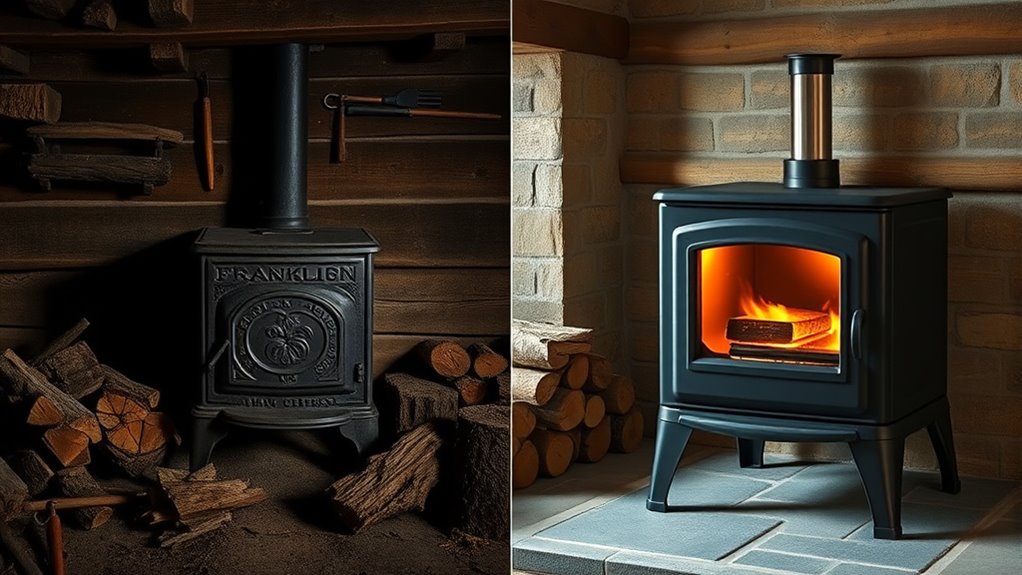
Long before modern stoves, people relied on simple methods to stay warm, often gathering around open fires or using basic pits to contain and control the heat. Primitive fires were among the earliest heating techniques, where you’d build a fire in a designated spot and tend to it carefully. These fires provided warmth, light, and a way to cook food. You might have used stones or dirt to create a makeshift fire pit, helping to contain the flames and radiate heat more effectively. Over time, people learned to improve these primitive fires, adding fuel management and ventilation techniques to enhance safety and efficiency. These basic heating methods laid the foundation for more sophisticated systems, as early humans sought ways to stay warm more efficiently and safely in colder environments. Additionally, the development of fire containment techniques allowed for better control and safety during heating, which was essential as societies advanced their heating technologies. As these innovations progressed, they eventually led to the creation of more durable and controllable heating devices, shaping the evolution of household heating.
The Invention of the Cast Iron Stove
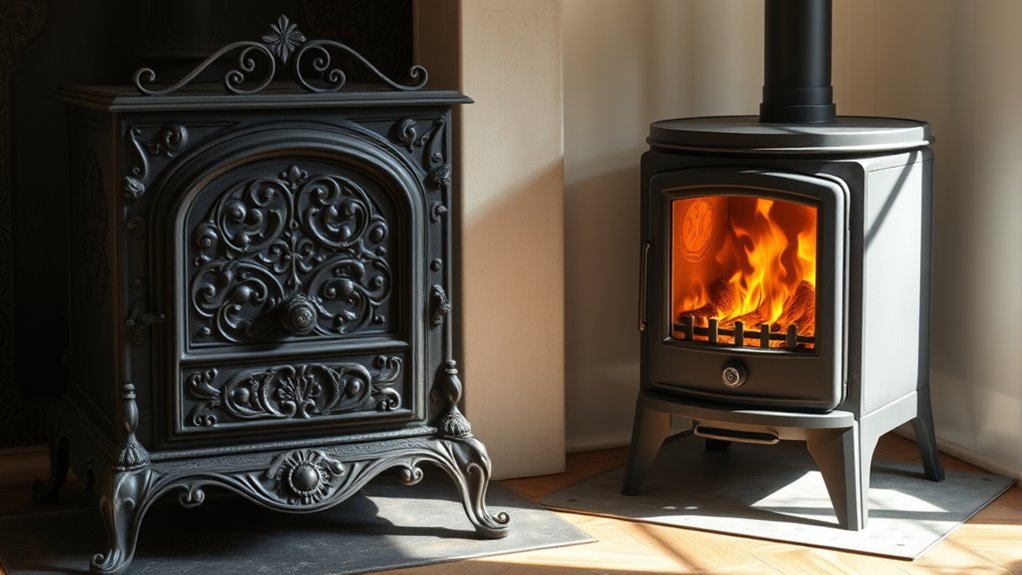
The invention of the cast iron stove marked a significant advancement in home heating technology, transforming how people managed warmth indoors. Its development relied heavily on cast iron manufacturing, which allowed for durable, heat-retentive components that could withstand high temperatures. Unlike earlier, simple metal or brick designs, this stove introduced a more efficient way to contain and distribute heat. Historical stove designs prior to this focused on open fires or basic hearths, but the cast iron stove offered a controlled, enclosed environment for burning wood. This innovation made heating more reliable, safer, and easier to maintain. By combining craftsmanship with new materials, manufacturers created a product that improved comfort and efficiency, setting the stage for future improvements in home heating technology. The widespread adoption of cast iron stoves also contributed to the development of home heating innovations, which were further enhanced by advances in ventilation and safety features. Additionally, the enhanced heat retention properties of cast iron enabled designs that could incorporate multiple cooking surfaces, making the stove more versatile for household use. Furthermore, the durability of cast iron facilitated innovations in stove design that improved efficiency and safety for users.
Benjamin Franklin’s Contributions to Stove Design
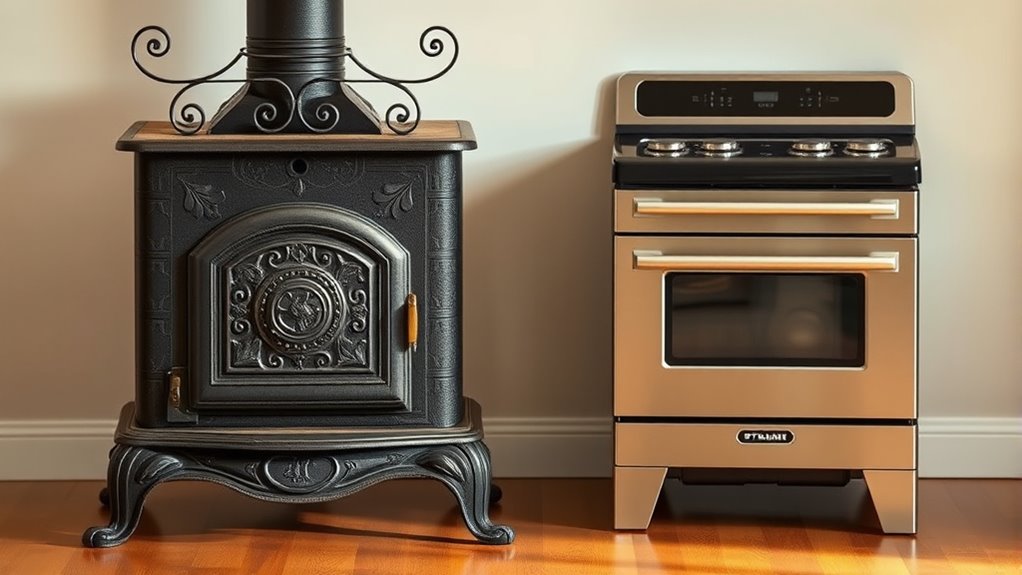
Benjamin Franklin revolutionized stove design with his innovative ideas to improve efficiency and reduce emissions. His experiments led to better airflow and heat retention, making stoves safer and more effective. These advancements considerably impacted how homes stayed warm and environmentally friendly.
Franklin’s Innovative Designs
Although many associate stove design with practicality, Benjamin Franklin’s innovations transformed how people heated their homes. He prioritized wood stove aesthetics, making designs that were not only functional but visually appealing. Franklin’s stoves improved heat distribution, ensuring warmth spread evenly throughout rooms. He also expanded fuel type options, allowing users to choose different kinds of wood or even coal, increasing flexibility and efficiency. His designs featured airtight chambers and smokeless operation, which reduced smoke and waste. Franklin’s focus on safety and efficiency led to innovations like improved air flow and better insulation. These advancements made stoves more effective, cleaner, and more attractive, setting new standards for home heating. His inventive approach laid the groundwork for future stove improvements, blending form with function seamlessly.
Emission Reduction Efforts
Building on his focus on efficiency and safety, Franklin also dedicated efforts to reducing emissions from wood stoves. He believed that improving fuel efficiency could lower smoke and pollutants released into the air. Franklin’s design innovation included better combustion chambers that promoted more complete burning of wood, which minimized smoke production. His stove designs aimed to maximize heat output while reducing harmful emissions, making them more environmentally friendly. By enhancing airflow and insulation, Franklin’s innovations helped achieve cleaner combustion processes. These efforts not only benefited public health by decreasing smoke pollution but also demonstrated a practical approach to emission reduction through thoughtful design. Franklin’s contributions laid an important foundation for future advancements in environmentally conscious stove technology. Sound design techniques can be applied to document and analyze Franklin’s innovations, providing a deeper understanding of their impact. Incorporating modern emission technologies could further enhance the environmental benefits of his designs and improve overall efficiency. Additionally, his work inspired ongoing research into environmentally friendly solutions for heating appliances, emphasizing the importance of sustainable practices in household technology.
Impact on Heating Efficiency
Franklin’s innovations in stove design considerably boosted heating efficiency by optimizing how heat is generated and distributed. He focused on improving combustion efficiency, ensuring that more heat was extracted from each log, reducing wasted energy. His design features, such as airtight seals and better airflow, allowed for more complete combustion, increasing heat output. Additionally, Franklin emphasized effective heat distribution within a space by incorporating baffle systems and improved airflow paths. These advancements meant your stove could produce more warmth while consuming less fuel. The result was a significant increase in overall heating efficiency, making homes warmer and more comfortable. Franklin’s contributions laid the groundwork for modern stove designs, emphasizing the importance of maximizing combustion efficiency and optimal heat distribution for better energy use. Enhanced stove efficiency is a key principle that continues to influence modern innovations in heating technology.
The Industrial Revolution and Mass Production
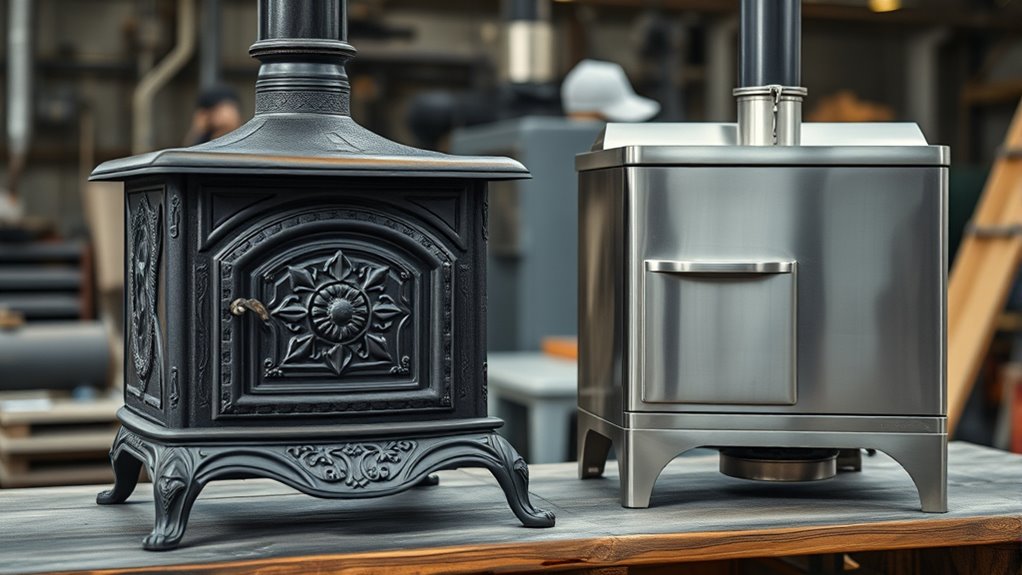
The Industrial Revolution transformed how wood stoves were manufactured by introducing mass production techniques that made them more affordable and widely available. This shift improved historical accuracy in manufacturing methods and showcased technological advancements, ensuring consistent quality. You’ll notice that factories enabled large-scale production, reducing costs and increasing accessibility for households. The key benefits included:
- Faster production times
- Lower prices for consumers
- Standardized parts for easier repairs
Additionally, the adoption of sound engineering principles during this era enhanced overall stove durability and safety. These innovations allowed wood stoves to reach a broader audience, fueling the progression from artisanal to industrial manufacturing. The integration of technological progress in design further improved efficiency and usability, making heating technology more practical for everyday use. The increased use of mass production techniques helped meet the growing demand for reliable heating solutions. As a result, more homes gained reliable heating, and the industry evolved through industrial innovation. This era laid the foundation for future improvements in stove design and efficiency, making heating technology more efficient and practical for everyday use.
Innovations in Safety and Efficiency
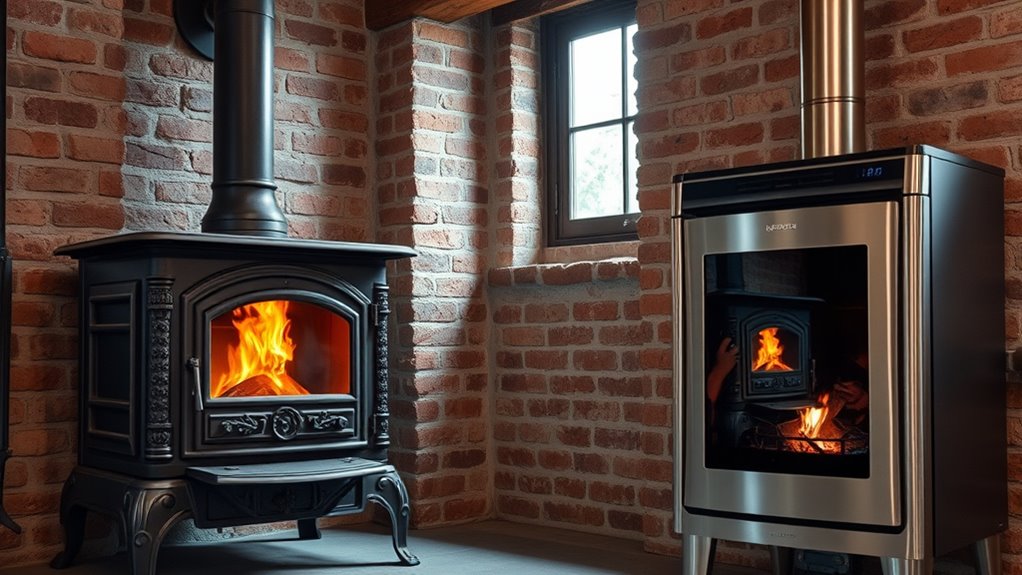
As technology advanced, innovations in safety and efficiency markedly improved wood stoves, making them safer to use and more energy-efficient. Improved designs now include better chimney maintenance features, reducing creosote buildup and preventing chimney fires. Modern stoves often have sealed doors and safety shut-offs that prevent accidental sparks and smoke leaks. Fuel efficiency also saw significant gains, with airtight combustion chambers and catalytic converters maximizing heat output while minimizing wood consumption. These enhancements not only protect your home but also save you money on fuel. Additionally, fire safety measures have become more sophisticated, further reducing the risk of house fires. Chimney maintenance is now easier with integrated cleaning tools and accessible designs, helping homeowners keep their systems in optimal condition. Proper wood sourcing from responsibly managed forests further supports sustainable and environmentally friendly heating practices. Regular chimney cleaning and inspections are essential for maintaining optimal performance and safety. By prioritizing chimney maintenance and adopting these innovative features, you guarantee safer operation and more efficient heating, making your wood stove a reliable, eco-friendly choice for your home. Additionally, incorporating modern heating technologies can further enhance overall energy efficiency and safety.
The Rise of Modern Wood Stove Technologies
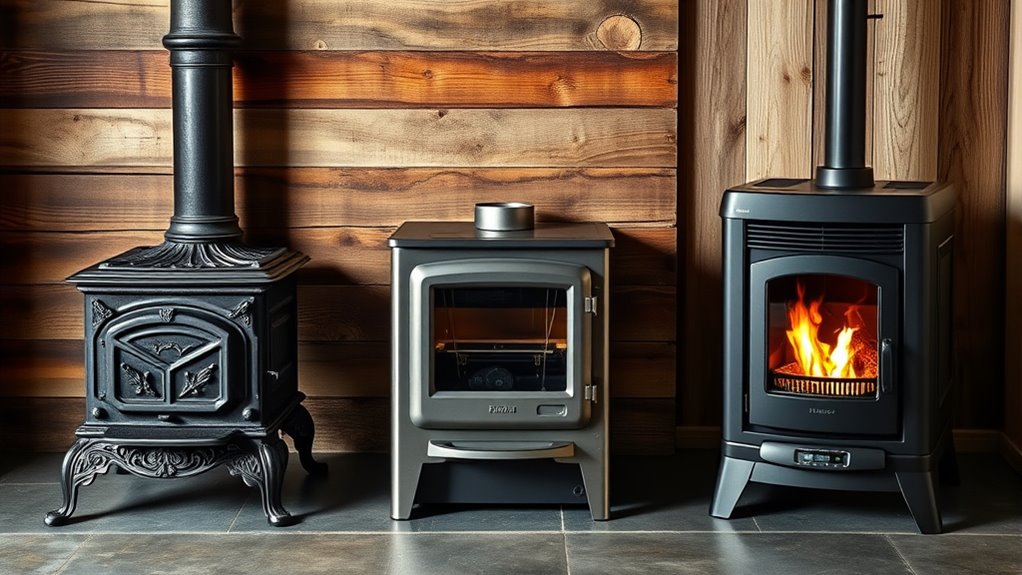
Advancements in safety and efficiency have paved the way for a new wave of innovative wood stove technologies. Modern designs focus on optimizing performance while enhancing aesthetics. You’ll notice the use of advanced wood stove materials, such as cast iron and steel, which improve durability and heat retention. These stoves often feature sleek aesthetic designs that blend seamlessly with contemporary interiors. Key innovations include:
- Improved combustion chambers for cleaner, more efficient burning
- Precise air control systems for better heat regulation
- Compact, stylish frames that elevate room decor
- Audi Tuning techniques have inspired some of these precise control innovations, ensuring better heat management and efficiency. Additionally, performance tuning principles from automotive technology have contributed to optimizing heat output and fuel consumption in modern wood stoves.
These features make modern wood stoves not only reliable heating sources but also attractive focal points in your home. As technology progresses, expect even smarter, more eco-friendly options to emerge, further transforming your heating experience.
Environmental Concerns and Eco-Friendly Models
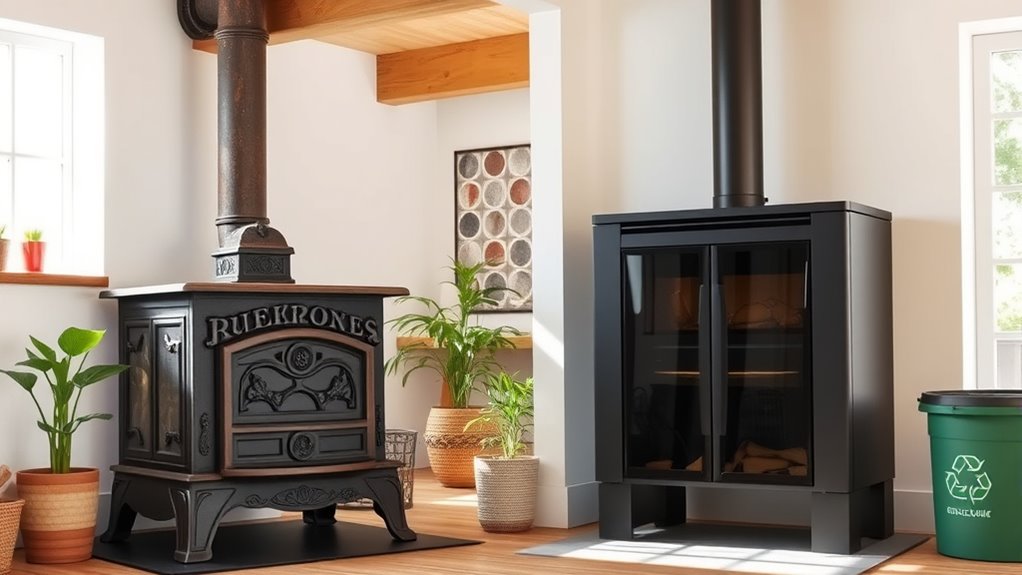
Growing environmental concerns have prompted manufacturers and consumers alike to seek eco-friendly wood stove options. You’ll find many models now use biomass alternatives and renewable fuels to reduce emissions and improve efficiency. These stoves often feature advanced combustion systems that burn wood more completely, minimizing smoke and particulate matter. Some models even utilize pelletized fuels made from compressed sawdust or agricultural waste, making use of renewable resources and decreasing reliance on traditional firewood. By choosing eco-friendly stoves, you help lower your carbon footprint and support sustainable practices. These innovative designs not only meet growing environmental standards but also deliver reliable heat with fewer pollutants. Embracing biomass alternatives and renewable fuels makes your wood stove more environmentally responsible without sacrificing performance.
Regulations and Safety Standards
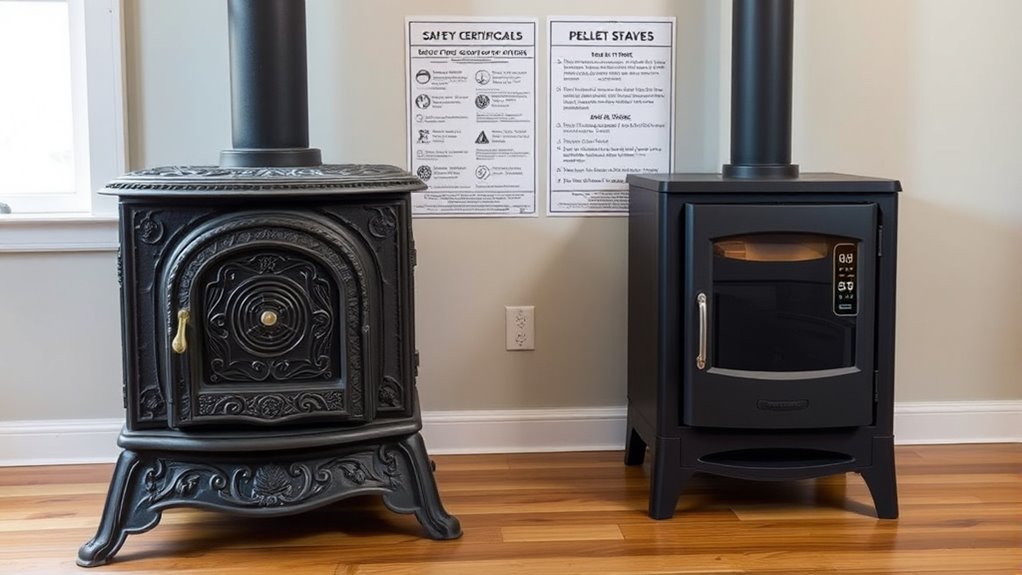
You need to understand how emission control measures reduce harmful pollutants from wood stoves. Proper installation safety protocols guarantee your stove operates safely and efficiently. Certification and compliance standards help you choose models that meet safety and environmental regulations.
Emission Control Measures
To reduce air pollution and protect public health, governments around the world have implemented strict emission control measures and safety standards for wood stoves. These regulations aim to limit harmful pollutants released during combustion, especially when burning biomass fuels indoors. Proper standards guarantee stoves produce fewer emissions, improving indoor air quality and safeguarding vulnerable populations.
You should be aware that modern regulations often require stoves to meet specific emission limits and incorporate advanced technologies. Key aspects include:
- Use of certified catalytic converters to reduce particulate matter
- Restrictions on burning unseasoned or wet wood
- Regular inspections to ensure compliance
Installation Safety Protocols
Installing a wood stove safely requires strict adherence to regulations and safety standards designed to prevent accidents and reduce fire risks. First, ensure proper chimney maintenance; a clean, well-maintained chimney prevents creosote buildup, which can cause chimney fires. Follow clearance requirements to keep combustible materials away from the stove and chimney. Proper fuel storage is vital—store wood in a dry, well-ventilated area away from the stove to avoid accidental ignition. Use approved materials like fire-resistant hearth pads beneath the stove. Always install smoke and carbon monoxide detectors nearby, checking them regularly. Adhering to these safety protocols reduces hazards and guarantees your wood stove operates efficiently and safely within your home.
Certification and Compliance
Have you ever wondered how to guarantee your wood stove meets safety standards? Certification and compliance are key to ensuring your stove is safe and efficient. Certification standards set the benchmarks for safety, emissions, and performance, while compliance regulations enforce these standards. To stay compliant, you should:
- Verify your stove has proper certification labels from recognized agencies
- Regularly check for updates on safety standards and regulations
- Choose models that meet or exceed current compliance requirements
The Revival of Wood Stoves in Contemporary Homes
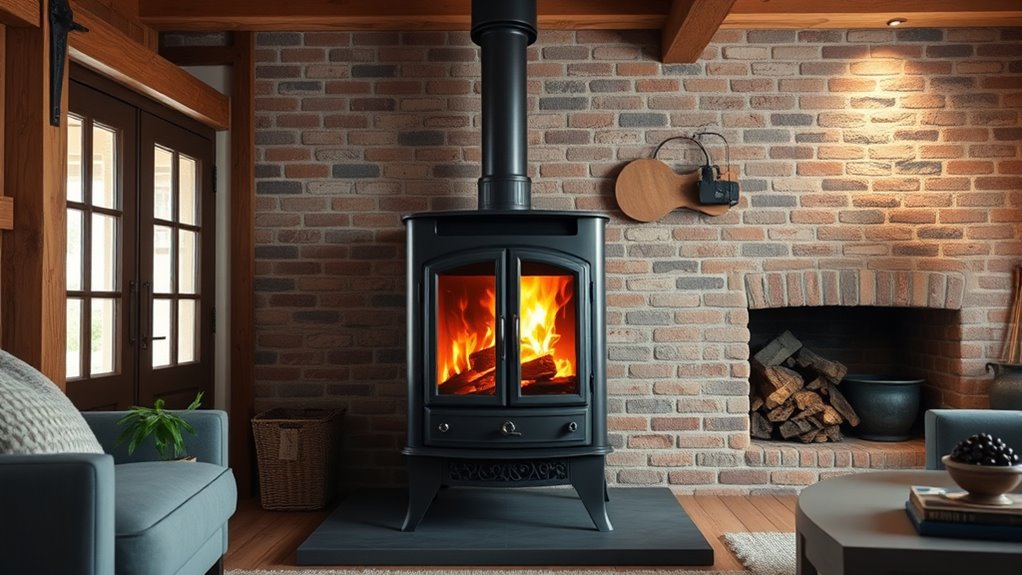
Despite their decline in the mid-20th century, wood stoves are making a notable comeback in modern homes. Today, many homeowners appreciate their cultural symbolism, connecting to traditions and a simpler way of life. The aesthetic appeal of wood stoves adds warmth and charm to contemporary spaces, blending rustic elegance with modern design. You might choose a sleek, minimalist model or a vintage-inspired piece, but both evoke a cozy atmosphere. This revival isn’t just about function; it’s about making a statement. As energy awareness grows, wood stoves offer an eco-friendly alternative to electric and gas heating, reinforcing their relevance. Their resurgence reflects a desire for sustainability, comfort, and a touch of timeless style in today’s increasingly digital world.
Future Trends in Wood Stove Design
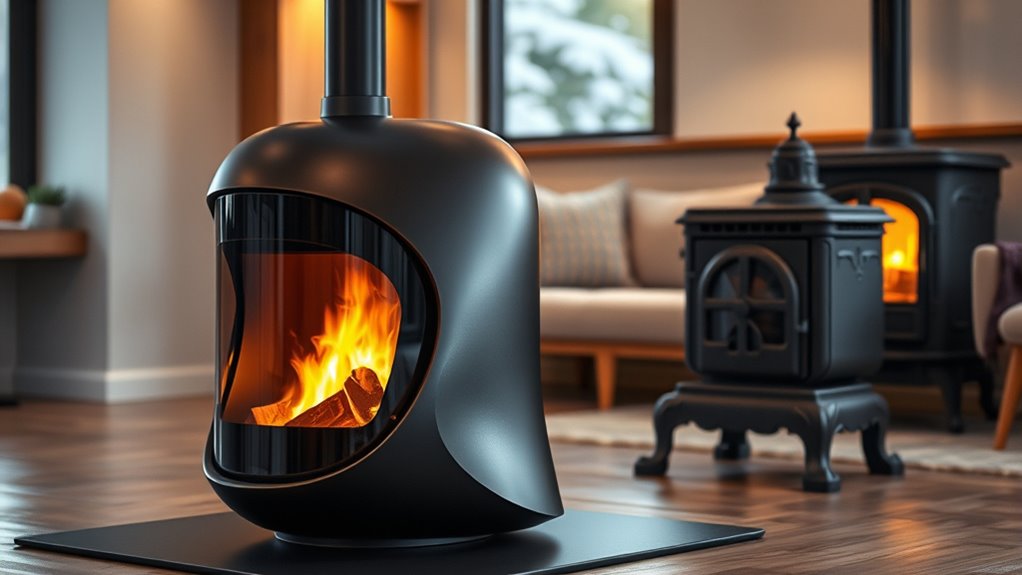
Future wood stove designs will likely incorporate smart technology to improve efficiency and user control. They’ll also use eco-friendly materials to reduce environmental impact, while safety features become more advanced to protect your home. These innovations aim to make wood stoves safer, greener, and more convenient for modern living.
Smart Technology Integration
As technology advances, wood stove designs are increasingly integrating smart features that enhance efficiency, safety, and user convenience. You can now control your stove remotely with smart thermostats and monitor performance from anywhere. These innovations allow you to optimize heat output, conserve fuel, and prevent issues before they escalate. Key benefits include:
- Precise temperature regulation through smart thermostats
- Real-time updates via remote monitoring systems
- Automated safety alerts for potential problems
Eco-Friendly Materials Usage
Advancements in eco-friendly materials are shaping the future of wood stove design by promoting sustainability and reducing environmental impact. You’ll see more stoves incorporating biomass alternatives, such as compressed sawdust or agricultural waste, which burn cleaner and produce fewer emissions. Manufacturers are increasingly prioritizing sustainable sourcing, ensuring materials come from responsibly managed forests or recycled sources. These innovations reduce reliance on traditional wood and minimize deforestation. Eco-friendly materials also enhance stove efficiency and longevity, making them more appealing to environmentally conscious consumers. By integrating sustainable materials, future wood stoves will not only heat your home effectively but also lessen your carbon footprint. This shift reflects a broader commitment to eco-conscious design, aligning functionality with environmental responsibility.
Enhanced Safety Features
Enhanced safety features are becoming a key focus in the evolution of wood stove design, aiming to protect users and prevent accidents. Modern innovations prioritize fire safety by integrating automatic shut-off systems, improved airflow controls, and heat-resistant glass doors. These features reduce the risk of fires and burns, ensuring safer operation. Material durability also plays a essential role; high-quality, heat-resistant materials extend the stove’s lifespan and maintain structural integrity under high temperatures. To maximize safety, manufacturers are incorporating:
- Temperature sensors that trigger automatic shut-offs
- Insulation layers to prevent external heat transfer
- Robust, fire-safe materials resistant to warping and corrosion
Frequently Asked Questions
How Did Early Humans Control Fire for Heating Purposes?
You might wonder how early humans controlled fire for heating. They started with prehistoric fires, learning to keep them burning and prevent them from spreading. Over time, they developed fire control techniques like creating barriers, digging fire pits, and sheltering fires from wind. These methods helped them manage heat, safety, and even cooking, laying the foundation for more advanced fire use in later societies.
What Materials Were Used in Primitive Heating Devices Before Stoves?
You should know that primitive heating devices relied on primitive fuel sources like wood, animal dung, and grasses. Early heating methods involved simple setups, such as pits or stones that contained burning material. These primitive tools allowed you to retain and direct heat, making indoor spaces warmer. Before the invention of stoves, early heating depended on these basic methods, harnessing primitive fuel to generate warmth efficiently in cold environments.
How Did Franklin’S Stove Improve Indoor Air Quality?
Imagine a time when indoor pollution threatened your family’s health. Franklin’s stove dramatically improved ventilation, reducing smoke and harmful gases. Its design promoted better airflow, which meant cleaner air inside your home. By controlling the fire’s draft, Franklin’s stove minimized indoor air pollution, making your space safer and more comfortable. This innovation marked a significant step toward healthier living environments, showcasing how smarter design can transform everyday life.
What Were the Major Challenges During the Industrialization of Wood Stoves?
During industrialization, you face major challenges like technological limitations that hinder stove efficiency and safety improvements. Resource scarcity also posed problems, making it harder to access affordable, quality materials for manufacturing. These issues slowed innovation and widespread adoption, forcing manufacturers to innovate within constraints. Overcoming these challenges required advances in design and technology, ultimately leading to more efficient, safer, and sustainable wood stoves for consumers.
How Do Modern Eco-Friendly Stoves Reduce Emissions Effectively?
Imagine you’re guiding a ship through a storm; modern eco-friendly stoves are your lighthouse. They use sustainable combustion and advanced emission reduction techniques to minimize pollutants. By optimizing airflow and burning efficiency, these stoves cut down emissions considerably, helping you protect the environment. You’ll find that these innovations make cooking safer, cleaner, and more sustainable, steering us toward a greener future with every meal you prepare.
Conclusion
As you explore the charming evolution of wood stoves, you’ll see how they’ve quietly adapted to meet modern needs. From humble beginnings to eco-conscious innovations, these stoves continue to warm homes while embracing safety and efficiency. Their subtle transformation hints at a future where tradition and technology blend seamlessly. By appreciating this history, you can better understand how these timeless fixtures softly shape our cozy, sustainable living spaces.


